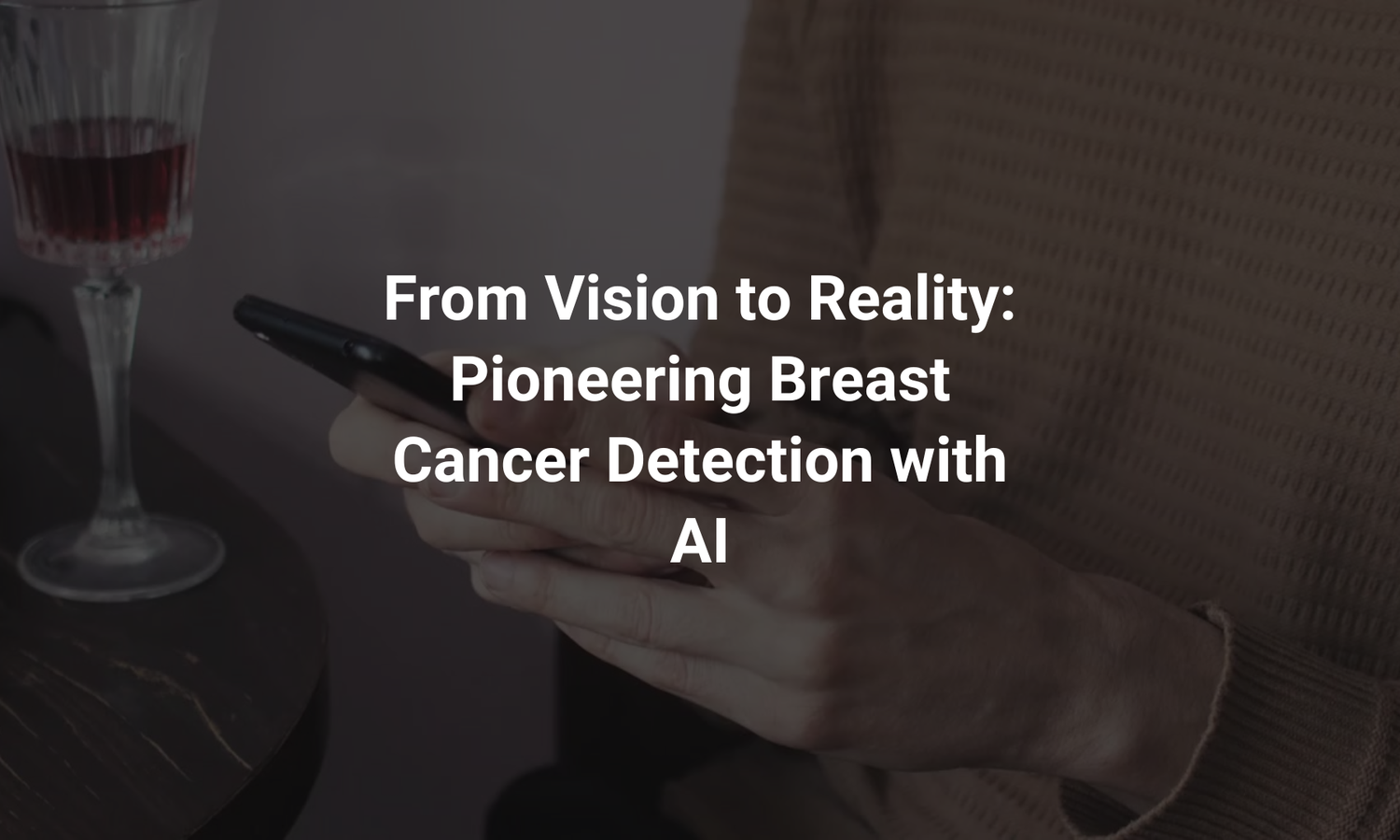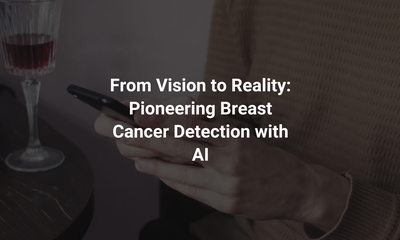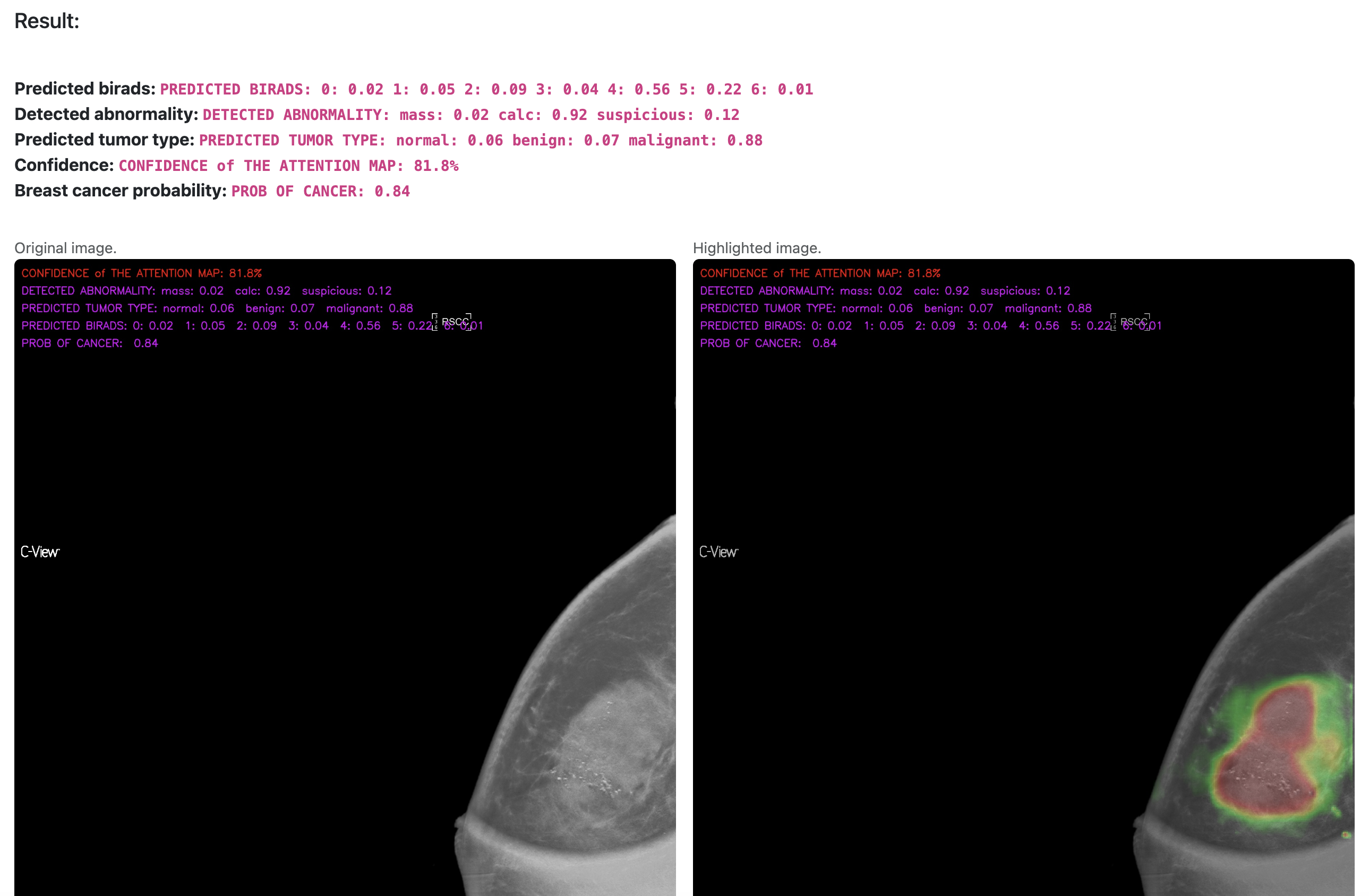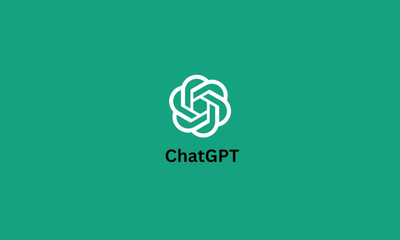Từ Tầm Nhìn Đến Hiện Thực: Tiên Phong Phát Hiện Ung Thư Vú Bằng Trí Tuệ Nhân Tạo
By khoanc, at: 21:23 Ngày 27 tháng 5 năm 2024
Thời gian đọc ước tính: __READING_TIME__ phút


Mở đầu
Ngày nay, chăm sóc sức khỏe, việc phát hiện sớm ung thư vú là một tia hy vọng, làm tăng đáng kể cơ hội điều trị thành công và sống sót. Khi bước vào kỷ nguyên trí tuệ nhân tạo (AI) kết hợp với khoa học y tế, tiềm năng cách mạng hóa việc phát hiện và chẩn đoán ung thư vú là rất lớn. Bài viết này kể lại hành trình của một dự án đầy tham vọng nhằm tận dụng sức mạnh của AI để giúp phát hiện ung thư vú sớm trở nên dễ tiếp cận hơn, chính xác hơn và hiệu quả hơn.
Tổng quan ý tưởng
Cảm hứng cho mô hình AI này xuất phát từ một nhận thức đơn giản nhưng sâu sắc: bất chấp những tiến bộ trong công nghệ y tế, quá trình phát hiện ung thư vú vẫn còn nhiều thách thức, bao gồm sự khác biệt trong chẩn đoán và nhu cầu về các phương pháp phát hiện cá nhân hóa và chính xác hơn. Được thúc đẩy bởi mong muốn tạo ra sự khác biệt, dự án đã bắt tay vào nhiệm vụ phát triển một mô hình AI không chỉ nâng cao độ chính xác của việc phát hiện ung thư vú mà còn phục vụ như một công cụ đa năng thích ứng với nhiều bộ dữ liệu và tình huống lâm sàng khác nhau.
Xây dựng nền tảng
Chìa khóa của việc phát triển mô hình AI này là việc lựa chọn và tích hợp sáu bộ dữ liệu công khai, mỗi bộ cung cấp những hiểu biết độc đáo về hình ảnh ung thư vú. Các bộ dữ liệu này bao gồm:
- CMMD, nổi tiếng với hình ảnh và chú thích chụp nhũ ảnh chi tiết.
- DDSM, một bộ dữ liệu tiên phong đã thúc đẩy nghiên cứu AI về ung thư vú trong nhiều năm.
- INbreast, cung cấp hình ảnh độ phân giải cao và nhiều trường hợp khác nhau.
- VinDr-Mammo, cung cấp hình ảnh hiện đại với chú thích của chuyên gia.
- Phát hiện ung thư vú chụp nhũ ảnh sàng lọc RSNA, một bộ dữ liệu cuộc thi Kaggle đặt ra thách thức cho các mô hình AI với sự biến đổi trong thế giới thực.
- Cơ sở dữ liệu Hiệp hội phân tích hình ảnh nhũ ảnh (MIAS) v1.21, được biết đến với ý nghĩa lịch sử và các nghiên cứu trường hợp toàn diện.
Sự đa dạng và chiều sâu của các bộ dữ liệu này đã đặt nền tảng vững chắc cho mô hình AI, cho phép nó học hỏi từ nhiều loại hình ảnh, bất thường và dữ liệu nhân khẩu học của bệnh nhân.
Vượt qua thách thức
Hành trình không thiếu những trở ngại. Việc tích hợp dữ liệu từ nhiều nguồn đã tạo ra một thách thức đáng kể do sự khác biệt về định dạng hình ảnh, chú thích và chất lượng. Hơn nữa, việc đảm bảo độ chính xác của mô hình trên một phổ dữ liệu đa dạng như vậy đã thử thách cả sự khéo léo và sự kiên trì của chúng tôi. Một trở ngại lớn khác là việc cân bằng khả năng tổng quát của mô hình với khả năng đưa ra dự đoán chính xác trong các tình huống lâm sàng cụ thể.
Áp dụng một phương pháp đa chiều, chúng tôi đã giải quyết những thách thức này một cách trực diện. Các kỹ thuật tiền xử lý dữ liệu sáng tạo đã được sử dụng để chuẩn hóa các bộ dữ liệu, trong khi các thuật toán học máy tiên tiến đã được điều chỉnh để tăng cường hiệu quả học hỏi của mô hình. Thông qua thử nghiệm, hợp tác và sự tận tâm không ngừng nghỉ, dự án đã vượt qua những trở ngại này, mở đường cho những đột phá sẽ định hình sự phát triển của mô hình.
Phương pháp luận được tiết lộ
Lấy cảm hứng từ phương pháp "Học cách ghi nhớ các sản phẩm làm đẹp", mô hình AI của chúng tôi được thiết kế không chỉ để phân tích hình ảnh mà còn để hiểu và diễn giải chúng trong bối cảnh phát hiện ung thư vú. Phương pháp này cho phép mô hình thực hiện nhiều nhiệm vụ cùng một lúc, bao gồm:
- Dự đoán bản đồ chú ý các vùng bất thường, hướng dẫn các bác sĩ chuyên khoa đến các vùng quan tâm.
- Phát hiện các loại bất thường, chẳng hạn như khối u và vôi hóa, với độ chính xác cao.
- Phân loại các loại khối u thành bình thường, lành tính hoặc ác tính, hỗ trợ chẩn đoán sớm và lập kế hoạch điều trị.
- Ước tính điểm số BIRADS, cung cấp đánh giá tiêu chuẩn hóa các kết quả tìm kiếm.
- Dự đoán xác suất ung thư, cung cấp thước đo rủi ro định lượng.
Khung học tập đa nhiệm vụ này cho phép mô hình tận dụng sức mạnh của mỗi bộ dữ liệu, tăng cường độ chính xác và độ tin cậy dự đoán của nó.
Đột phá và hiểu biết
Trong suốt quá trình phát triển, một số hiểu biết quan trọng đã nổi lên. Đặc biệt, khả năng dự đoán chính xác bản đồ chú ý của mô hình đã cách mạng hóa cách các bác sĩ chuyên khoa có thể diễn giải chụp nhũ ảnh, làm nổi bật các khu vực tiềm ẩn mối nguy hiểm với độ chính xác đáng kể. Ngoài ra, mô hình đã chứng minh khả năng xuất sắc trong việc phân biệt giữa khối u lành tính và ác tính, một yếu tố quan trọng trong việc xác định hướng điều trị thích hợp.
Kết quả sơ bộ rất khả quan, cho thấy tiềm năng của mô hình trong việc tác động đáng kể đến lĩnh vực phát hiện ung thư vú. Những hiểu biết này không chỉ xác nhận hiệu quả của phương pháp học tập đa nhiệm vụ mà còn nhấn mạnh tầm quan trọng của việc tích hợp các bộ dữ liệu đa dạng để huấn luyện mô hình, đảm bảo nó có thể hoạt động hiệu quả trong nhiều tình huống khác nhau.
Bản demo: Cổng vào sự hợp tác
Để thu hẹp khoảng cách giữa phát triển lý thuyết và ứng dụng thực tiễn, một nền tảng demo đã được ra mắt (Bản demo Phát hiện ung thư vú bằng AI). Nền tảng này đóng vai trò là một hình ảnh trực quan về khả năng của mô hình AI, cho phép người dùng—cho dù là nhà đầu tư, bác sĩ hay nhà nghiên cứu—tương tác trực tiếp với mô hình. Thông qua bản demo, người dùng có thể tải lên hình ảnh chụp nhũ ảnh và nhận được phân tích tức thì, bao gồm bản đồ chú ý, phát hiện bất thường, phân loại khối u, điểm số BIRADS và dự đoán xác suất ung thư.
Bản demo không chỉ là công cụ trình diễn mà còn là phương tiện để thu thập phản hồi quý giá. Vòng phản hồi này rất quan trọng đối với việc cải thiện liên tục của mô hình, cho phép nhóm tinh chỉnh và điều chỉnh mô hình dựa trên việc sử dụng trong thế giới thực và hiểu biết của chuyên gia.

Cải tiến và thách thức trong tương lai
Khi hướng đến tương lai, hành trình nâng cao và mở rộng quy mô mô hình AI vừa thú vị vừa đầy thử thách. Những cải tiến được lên kế hoạch bao gồm:
- Nâng cao độ chính xác của mô hình: Bằng cách kết hợp thêm nhiều bộ dữ liệu đa dạng và tận dụng những tiến bộ trong AI và học máy, chúng tôi hướng tới việc cải thiện hơn nữa độ chính xác chẩn đoán của mô hình.
- Cải thiện trải nghiệm người dùng: Những cải tiến đối với nền tảng demo sẽ tập trung vào việc làm cho nó trực quan và cung cấp thông tin hơn cho người dùng, cung cấp những hiểu biết và lời giải thích rõ ràng hơn về kết quả của mô hình.
- Mở rộng quy mô cho sử dụng toàn cầu: Mở rộng khả năng của mô hình để phục vụ các dân số và hệ thống chăm sóc sức khỏe khác nhau trên toàn thế giới, đảm bảo nó có thể tạo ra tác động toàn cầu.
Tuy nhiên, những tiến bộ này đi kèm với những thách thức riêng:
- Bảo mật và quyền riêng tư dữ liệu: Vì mô hình xử lý thông tin sức khỏe nhạy cảm, việc đảm bảo tiêu chuẩn cao nhất về quyền riêng tư và bảo mật dữ liệu là điều tối quan trọng.
- Tích hợp lâm sàng: Tích hợp liền mạch mô hình AI vào quy trình làm việc lâm sàng hiện có mà không làm gián đoạn hoặc làm phức tạp các hoạt động của các nhà cung cấp dịch vụ chăm sóc sức khỏe.
- Sự chấp thuận của cơ quan quản lý: Điều hướng khung cảnh phức tạp của các quy định về thiết bị y tế để được chấp thuận sử dụng lâm sàng, một bước quan trọng để được áp dụng rộng rãi.
Lời kêu gọi hành động
Hành trình phát triển mô hình AI này để phát hiện ung thư vú là minh chứng cho sức mạnh của công nghệ trong việc tạo ra tác động ý nghĩa đến chăm sóc sức khỏe. Khi chúng tôi tiếp tục tinh chỉnh và mở rộng mô hình của mình, chúng tôi mời sự hợp tác, đầu tư và nghiên cứu để cùng tham gia vào nỗ lực này. Cùng nhau, chúng ta có thể vượt qua giới hạn của những điều có thể trong việc phát hiện ung thư sớm, cải thiện kết quả cho bệnh nhân trên toàn thế giới.
Nếu bạn là nhà nghiên cứu, bác sĩ lâm sàng, nhà đầu tư, hoặc chỉ đơn giản là người đam mê cách mạng hóa chăm sóc sức khỏe thông qua công nghệ, chúng tôi khuyến khích bạn liên hệ. Khám phá bản demo, cung cấp phản hồi và hãy cùng nhau khám phá cách chúng ta có thể hợp tác để biến tầm nhìn này thành hiện thực.
Kết luận
Nhìn lại hành trình này từ tầm nhìn đến hiện thực, rõ ràng là con đường tiên phong phát hiện ung thư vú bằng AI vừa đầy thách thức vừa đầy ý nghĩa. Bằng cách đón nhận sự đổi mới, vượt qua khó khăn và thúc đẩy sự hợp tác, chúng ta đang đứng trước ngưỡng cửa của việc chuyển đổi chẩn đoán ung thư vú, giúp phát hiện sớm trở nên dễ tiếp cận và chính xác hơn bao giờ hết. Tương lai tươi sáng, và cùng nhau, chúng ta có thể tạo ra sự khác biệt trong cuộc sống của hàng triệu người.
Lời cảm ơn
Chúng tôi bày tỏ lòng biết ơn chân thành đến tất cả những người cộng tác, cố vấn và các tổ chức đã hỗ trợ dự án này. Những hiểu biết, chuyên môn và sự động viên của các bạn đã vô cùng quý giá trong việc biến tầm nhìn này thành hiện thực.
Khi câu chuyện về sự đổi mới, khả năng phục hồi và hợp tác này kết thúc, chúng ta đang ở một thời điểm then chốt trong cuộc chiến chống lại ung thư vú. Việc phát triển và hoàn thiện mô hình AI của chúng ta không chỉ là câu chuyện về thành tựu công nghệ; đó là một tia hy vọng cho hàng triệu phụ nữ trên toàn thế giới và là minh chứng cho những gì có thể đạt được khi những bộ óc xuất chúng cùng nhau hướng tới một mục tiêu chung.
Cùng nhau đón nhận tương lai
Tương lai của việc phát hiện ung thư vú không chỉ nằm trong các thuật toán và bộ dữ liệu mà chúng ta đã phát triển mà còn nằm trong tay cộng đồng toàn cầu—các bác sĩ lâm sàng, nhà nghiên cứu, nhà công nghệ và những người ủng hộ—những người chia sẻ tầm nhìn của chúng ta về một thế giới mà ung thư vú có thể được phát hiện chính xác và sớm. Hành trình của chúng ta cho đến nay đã đặt nền móng vững chắc, nhưng chính những sự hợp tác đang chờ đợi chúng ta sẽ thúc đẩy dự án này đến tiềm năng đầy đủ của nó.
Lời kêu gọi đổi mới và hợp tác
Chúng ta đang ở ngã ba đường nơi sự đổi mới gặp gỡ ứng dụng thực tiễn, nơi công nghệ gặp gỡ nhân loại. Đây là lời kêu gọi gửi đến bạn—cho dù bạn đang trong lĩnh vực y tế, nghiên cứu AI, chính sách chăm sóc sức khỏe, hay đơn giản là có niềm đam mê tạo ra sự khác biệt—hãy cùng tham gia với chúng tôi. Chuyên môn, nguồn lực và hiểu biết của bạn có sức mạnh định hình tương lai của chăm sóc sức khỏe, giúp phát hiện ung thư vú sớm và chính xác trở thành tiêu chuẩn mà tất cả mọi người đều có thể tiếp cận.
Nhận thức về con đường phía trước
Trong khi chúng ta ăn mừng những tiến bộ của mình, chúng ta vẫn nhận thức rõ những thách thức đang chờ đợi phía trước. Việc tích hợp AI vào các thiết lập lâm sàng, điều hướng khung cảnh quy định phức tạp và đảm bảo sử dụng công nghệ một cách có đạo đức trong chăm sóc sức khỏe là những thách thức mà chúng ta phải cùng nhau đối mặt. Đây không chỉ là những trở ngại mà còn là những cơ hội để chúng ta thiết lập những tiêu chuẩn mới, để đảm bảo rằng sự đổi mới phục vụ nhân loại theo cách có đạo đức, hiệu quả và nhân văn nhất có thể.
Cùng chúng tôi trên hành trình này
Nếu bạn được truyền cảm hứng bởi khả năng chuyển đổi chăm sóc sức khỏe và cứu sống bằng công nghệ, chúng tôi mời bạn liên hệ. Cho dù đó là thông qua hợp tác, đầu tư hay chia sẻ kiến thức, sự đóng góp của bạn có thể giúp đẩy nhanh tiến độ và mở rộng tác động của chúng tôi. Truy cập Bản demo Phát hiện ung thư vú bằng AI để xem công việc của chúng tôi đang hoạt động, cung cấp phản hồi hoặc thảo luận về các mối quan hệ đối tác tiềm năng.
Lời kết
Khi chúng ta nhìn về chân trời, hành trình của mô hình AI của chúng ta để phát hiện ung thư vú mới chỉ bắt đầu. Với mỗi thách thức mà chúng ta vượt qua và mỗi cột mốc mà chúng ta đạt được, chúng ta tiến gần hơn đến một thế giới mà ung thư vú không còn gây ra mối đe dọa như ngày nay. Cùng nhau, với sự hỗ trợ và hợp tác của bạn, chúng ta có thể biến tầm nhìn này thành hiện thực, cứu sống người dân và định hình tương lai của chăm sóc sức khỏe cho các thế hệ mai sau.
Lòng biết ơn sâu sắc
Một lần nữa, chúng tôi bày tỏ lòng biết ơn sâu sắc nhất đến tất cả những người đã đóng góp vào dự án này. Niềm tin của các bạn vào tầm nhìn của chúng tôi, sự tận tâm và công việc chăm chỉ của các bạn đã đưa chúng ta đến nơi chúng ta đang có ngày hôm nay—một bước tiến gần hơn để tạo ra sự khác biệt đáng kể trong cuộc chiến chống lại ung thư vú.
Cùng nhau, chúng ta có thể và sẽ tạo ra sự khác biệt.





